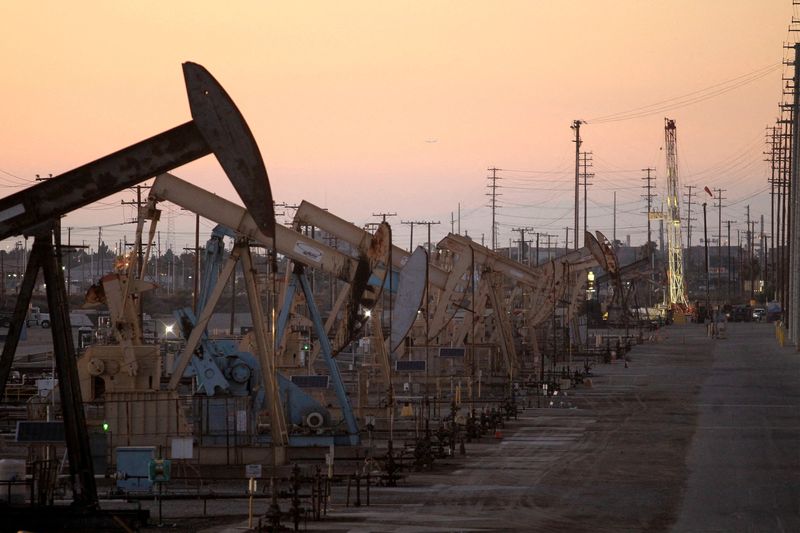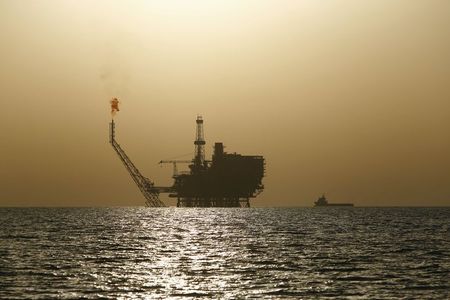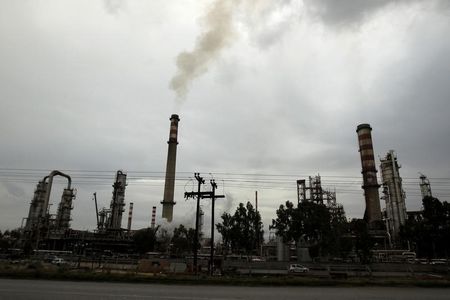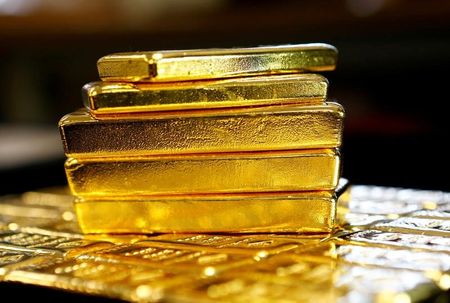Commodities
IEA raises oil demand outlook again but still lags OPEC


© Reuters. FILE PHOTO: Oil rig pumpjacks, also known as thirsty birds, extract crude from the Wilmington Field oil deposits area near Long Beach, California July 30, 2013. REUTERS/David McNew/File Photo
By Noah Browning and Alex Lawler
LONDON (Reuters) -The International Energy Agency on Thursday raised its view on 2024 oil demand growth for a fourth time since November as Houthi attacks disrupt Red Sea shipping, though it remains far less bullish than producer group OPEC.
The Organization of the Petroleum-Exporting Countries (OPEC) and the IEA, which represents industrialised countries, have clashed in recent years over issues such as the long-term oil demand outlook and the need for investment in new supply.
World oil demand will rise by 1.3 million bpd in 2024, the IEA said in its latest report, up 110,000 bpd from last month. It forecast a slight supply deficit this year after OPEC+ members extended cuts, from a surplus previously.
rose as much as 80 cents a barrel towards $85 after the IEA report was released, touching its highest since November.
“Quite a bullish report, with upward revisions on demand growth, and lower supply growth estimates,” said UBS analyst Giovanni Staunovo.
The IEA had initially forecast 2024 demand growth of 860,000 bpd in June 2023. Demand rose by 2.3 million bpd last year.
“The slowdown in growth, already apparent in recent data, means that oil consumption reverts towards its historical trend after several years of volatility from the post-pandemic rebound,” the IEA said.
OPEC on Tuesday kept its demand growth forecast unchanged at 2.25 million bpd, meaning the views of OPEC and IEA remain nearly 1 million bpd apart, representing almost 1% of daily world demand.
Dovish signals from central banks indicated a path out of economic doldrums, the IEA said, but subdued economic data in China remains a concern.
Disruptions to shipping in the Red Sea region have forced more trade on to the longer route around the Cape of Good Hope, pushing up the number of barrels at sea to nearly 1.9 billion as of the end of February, the IEA said.
Longer routes boosted fuel demand and the loading of ships with fuel, or bunkering, in Singapore reached all-time highs.
ECONOMIC HEADWINDS
The IEA still thinks the cloudy economic outlook will weigh on demand, the agency noted, even as the challenges to shipping provide a short-term boost.
Growth will continue to be heavily skewed towards non-OECD countries, even as China’s dominance gradually fades, the IEA said. It expects China’s demand growth to slow to 620,000 bpd from 1.7 million bpd in 2023.
On the supply side, the IEA said growth from non-OPEC+ countries would continue to significantly eclipse oil demand expansion in 2024, although extended cuts by some OPEC+ members had tightened the balance.
Some OPEC+ members earlier this month extended voluntary cuts made in the first quarter until the end of June. The IEA said it was treating those cuts as being in place for the whole year, unwinding them only once OPEC+ confirms the move.
“On that basis, our balance for the year shifts from a surplus to a slight deficit, but oil tanks may get some relief as the massive volumes of oil on water reach their final destination,” the agency said.
Commodities
Gold and silver to continue to appreciate – Julius Baer

Investing.com – With another day of gains in and futures, the Swiss group Julius Baer has decided to change its outlook on commodities to constructive. The group now believes that both metals have the potential for further increases, as stated in a note sent to clients and the market on Friday morning.
The group mentioned that, in addition to U.S. monetary policy, the gold market is still dominated by Asia. “We have to recognize that the region’s willingness to pay for gold as a hedge against economic and geopolitical risks appears even greater than we expected,” said Carsten Menke, head of next-generation research at Julius Baer.
Weaker-than-expected U.S. economic data have revived hopes for interest rate cuts by the Federal Reserve (Fed, the U.S. central bank), boosting gold and silver prices. This could “be the missing incentive for safe-haven seekers in the Western world to return to the markets,” he added.
Central Bank Purchases in Focus
Central banks have been buying gold more for geopolitical reasons than economic ones, according to Julius Baer. In China, for example, there is a desire to reduce dependence on the U.S. dollar – important for avoiding potential sanctions.
The People’s Bank of China is believed to be responsible for at least 30% to 50% of all central bank purchases over the past two years. Although it shows signs of being price-sensitive, “its willingness to pay has increased as gold prices rise,” notes Julius Baer. It is expected that other monetary authorities will follow the same steps, moving away from the U.S. dollar.
remove ads
.
***
Want to leverage your strategies with stocks of companies related to commodities?
Then come to InvestingPro! By becoming a member of InvestingPro, you get access to features such as:
- ProPicks: AI-managed stock portfolios with proven results.
- ProTips: Quick and straightforward tips to simplify complex financial information.
- Advanced stock filter: Find the stocks that best meet your expectations based on hundreds of financial metrics.
- Turbo navigation: Investing.com pages load much faster, without any ads.
- Institutional-level financial data for thousands of stocks: Ideal for investors who want to conduct their own detailed evaluations.
- And many more services to be added soon!
Enjoy all this with an extra discount on 1 or 2-year Pro and Pro+ plans. Enter the code INVESTIR and enjoy!
Commodities
Goldman Sachs discusses what’s next for natural gas prices

Over the past three weeks, US prices have surged 30% to above $2.50 per million British thermal units (mm/BTU), fueled by production declines and increased feedgas demand for liquified natural gas (LNG) exports.
Moreover, recent producer cuts, maintenance events, and Freeport LNG’s normalization of gas demand post-outage have contributed to this rise. Cheniere’s announcement of no heavy maintenance for its liquefaction trains this year also supports higher prices.
In a Thursday note, Goldman Sachs strategists said the return of gas prices above $2/mmBtu aligns with their expectations, as production curtailments “would ultimately lead to lower storage congestion risks for this summer.”
“That said, we see only limited further upside from current levels, with stronger gas prices risking a return of congestion concerns,” they added.
Goldman notes that prices above $2/mmBtu reduce gas competitiveness compared to coal, with a $0.50/mmBtu increase potentially cutting gas demand by 1 billion cubic feet per day (Bcf/d), especially in shoulder months.
Moreover, higher prices may prompt the restart of previously shut-in wells. EQT (ST:), the largest producer in the Appalachia region, indicated it would resume production if prices sustainably exceed $1.50/mmBtu. And while Appalachia prices haven’t risen as much as NYMEX, the local hub has averaged $1.44/mmBtu month-to-date, up 10¢ from last month, strategists highlighted.
Elsewhere, European gas prices have also risen this summer, though less sharply than in the US.
Title Transfer Facility (TTF) prices increased 18% over the past three months to around 30 euros per megawatt-hour (MWh), holding steady in May.
remove ads
.
However, unlike the US market, this rally lacks fundamental support, with Northwest (NW) European gas storage at record-high levels, Goldman strategists pointed out.
“To be sure, NW European LNG imports have remained weak relative to last year – and are likely to get weaker in the coming weeks owing to a seasonal decline in global LNG production, exacerbated by outages at Australia’s Gorgon export project,” they said.
“Going forward, we expect healthy non-European demand for LNG to continue to incentivize a decline in European LNG imports vs last year,” they continued.
Commodities
Gold prices trim some weekly gains on tempered rate cut hopes

Investing.com– Gold prices fell slightly on Friday, trimming some of their gains for the week as comments from a slew of Federal Reserve officials offered a more sobering outlook on interest rate cuts.
The yellow metal had risen to nearly $2,400 an ounce this week in the immediate aftermath of some soft U.S. economic readings. But it pulled back from these levels on Thursday and Friday.
steadied at $2,377.40 an ounce, while expiring in June fell slightly to $2,381.10 an ounce by 00:19 ET (04:19 GMT).
Gold retreats as Fed officials downplay rate cuts, but weekly gains due
The yellow metal fell on Thursday after a string of Fed officials cautioned against bets on immediate reductions in interest rates.
Several members of the central bank’s rate setting committee said the central bank will need much more convincing that inflation was coming down beyond a marginally soft inflation reading for April.
This saw traders begin pricing out some expectations for a rate cut in September. The and also rebounded from earlier losses this week.
Still, some softer-than-expected readings put gold on course for a 0.7% weekly gain.
The yellow metal was also in sight of a record high of above $2,430 an ounce, although it appeared unlikely the level would be met in the near-term.
Other precious metals retreated on Friday, but were set for bumper weekly gains. fell 0.2% but were trading up 6.2% for the week, while fell 0.4% but were up 4.5% this week.
remove ads
.
Copper mixed amid middling China cues
Among industrial metals, one-month copper futures tumbled from two-year highs tracking middling economic data. But three-month copper futures pushed higher and were set for a stellar week as markets bet on tighter supplies and an eventual demand recovery in the coming months.
on the London Metal Exchange rose 0.6% to $10,445.0 a ton, while rose 0.3% to $4.8935 a pound.
Data from China on Friday painted a mixed picture of the economy. While grew more than expected, growth slowed and shrank at an accelerated pace. Growth in Chinese also slowed.
The readings presented a muddled outlook for the world’s biggest copper importer, as it rolled out more stimulus measures to shore up growth.
Three-month copper futures gained on the prospect of a demand recovery, and were up nearly 4% this week. They were also at two-year highs.

 Forex2 years ago
Forex2 years agoForex Today: the dollar is gaining strength amid gloomy sentiment at the start of the Fed’s week

 Forex2 years ago
Forex2 years agoHow is the Australian dollar doing today?

 Forex1 year ago
Forex1 year agoUnbiased review of Pocket Option broker

 Forex2 years ago
Forex2 years agoDollar to pound sterling exchange rate today: Pound plummeted to its lowest since 1985

 Cryptocurrency2 years ago
Cryptocurrency2 years agoWhat happened in the crypto market – current events today

 World2 years ago
World2 years agoWhy are modern video games an art form?

 Stock Markets2 years ago
Stock Markets2 years agoMorgan Stanley: bear market rally to continue

 Economy2 years ago
Economy2 years agoCrude oil tankers double in price due to EU anti-Russian sanctions

































